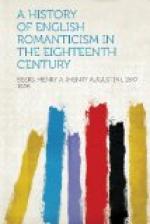“Bell’s Fugitive Poetry,” Vol. XI, (1791), has a section devoted to “poems in the manner of Milton,” by Evans, Mason, T. Warton and a Mr. P. (L’Amoroso).
[16] See James Thomson’s “City of Dreadful Night,” xxi. Also the frontispiece to Mr. E. Stedman’s “Nature of Poetry” (1892) and pp. 140-41 of the same.
[17] “Eighteenth Century Literature,” pp. 209, 212.
[18] “English Literature in the Eighteenth Century,” pp. 375, 379.
[19] Joseph mentions as one of Spenser’s characteristics, “a certain pleasing melancholy in his sentiments, the constant companion of an elegant taste, that casts a delicacy and grace over all his composition,” “Essay on Pope,” Vol. II. p. 29. In his review of Pope’s “Epistle of Eloisa to Abelard,” he says: “the effect and influence of Melancholy, who is beautifully personified, on every object that occurs and on every part of the convent, cannot be too much applauded, or too often read, as it is founded on nature and experience. That temper of mind casts a gloom on all things.
“‘But o’er the
twilight grows and dusky caves,’ etc.”
—Ibid, Vol.
I. p. 314.
[20] “The Grave,” by Robert Blair.
[21] The aeolian harp was a favorite property of romantic poets for a hundred years. See Mason’s “Ode to an Aeolus’s Harp” (Works, Vol. I. p. 51). First invented by the Jesuit, Kircher, about 1650, and described in his “Musurgia Universalis,” Mason says that it was forgotten for upwards of a century and “accidentally rediscovered” in England by a Mr. Oswald. It is mentioned in “The Castle of Indolence” (i. xl) as a novelty:
“A certain music never
known before
Here lulled the pensive melancholy
mind”—
a passage to which Collins alludes in his verses on Thomson’s death—
“In yon deep bed of
whispering reeds
His airy harp shall now be
laid.”
See “The Lay of the Last Minstrel” I. 341-42 (1805)
“Like that wild harp
whose magic tone
Is wakened by the winds alone.”
And Arthur Cleveland Coxe’s (Christian Ballads, 1840)
“It was a wind-harp’s
magic strong,
Touched by the breeze in dreamy
song,”
And the poetry of the Annuals passim.
[22] Cf. the “Elegy”:
“There at the foot of yonder nodding beech,” etc.
[23] “On a Distant Prospect of Eton College.”
[24] “Hymn to Adversity”
[25] “Ode on the Spring.”
[26] “Ward’s English Poets,” Vol. III. pp. 278-82.
[27] “Eighteenth Century Literature,” p. 233.
[28] “Essay on Pope.”
[29] See ante, p. 114.
[30] “Life of Collins.”
[31] Essay on “Pope.”
[32] Mr. Perry enumerates, among English imitators, Falconer, T. Warton, James Graeme, Wm. Whitehead, John Scott, Henry Headly, John Henry Moore, and Robert Lovell, “Eighteenth Century Literature,” p. 391. Among foreign imitations Lamartine’s “Le Lac” is perhaps the most famous.




